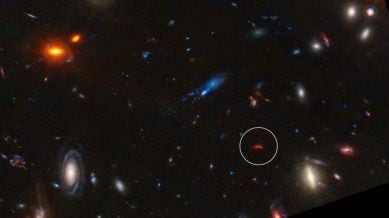Researchers find ‘star factory’ making stars 180 times faster than the Milky Way
The study suggests that similar star factories may have been widespread in the early universe, although many may still be hidden from current observations.

Astronomers in Sweden have made a groundbreaking discovery of a superheated galaxy, Y1, which acted as a “star factory” just 800 million years after the Big Bang, and said it is producing stars at a staggering rate 180 times faster than the Milky Way.
This observation provides crucial insights into the rapid growth of galaxies in the early universe.
A team, headed by Tom Bakx of Chalmers University of Technology in Sweden, utilised the Atacama Large Millimetre/submillimetre Array (ALMA) to measure the galaxy’s superheated cosmic dust temperature, analysing light that has travelled to Earth for 13 billion years.
In a study, A warm ultraluminous infrared galaxy just 600 million years after the big bang, published in a journal of the Royal Astronomical Society on November 12, the researchers said they have uncovered a previously hidden era in cosmic history when star formation occurred much more rapidly than it does today.
Bakx highlighted the importance of their findings, noting that previous observations indicated the presence of dust in this galaxy, making it the furthest instance of glowing dust directly detected. This led to the hypothesis that Y1 operates with a different, superheated mechanism of star formation.
Moreover, the research supports ongoing efforts to understand the formation conditions of the first generation of stars, known as “Population III (POP III)” stars, which are believed to have formed under markedly different conditions from those of current stars, called “Population I (POP I)” stars, like our sun. This discovery is set to enhance scientists’ understanding of early galaxy formation and the cosmic environment of the universe’s infancy.
Stars form in dense gas and dust complexes such as the Orion and Carina Nebulae, where young massive stars illuminate their surroundings. Recent ALMA observations have revealed a unique galaxy, Y1, that shows extraordinary brightness across wavelengths, particularly in the infrared. The high sensitivity of ALMA allowed researchers like Bakx and colleagues to determine that the dust in Y1 radiates at about -356°F (-180°C), indicating it functions as an active star factory, creating stars at an impressive rate of approximately 180 solar masses per year—an exceptional rate for 13 billion years ago.
Although this starburst phase is intense, it is believed to be short-lived in cosmological terms. The study suggests that similar star factories could have been common in the early universe, although many might remain hidden from current observations.
Bakx highlighted the importance of continuing the search for additional examples to understand these early stellar environments better.
Additionally, Y1 offers potential insights into the paradox of early galaxies containing more dust than older star populations would typically produce. As explained by team member Laura Sommovigo, this phenomenon indicates that warm, luminous dust could create the illusion of high dust volumes despite these galaxies being relatively young and lacking older stars that usually generate dust.
This finding posits that intense star formation in nascent galaxies could explain their unexpected dust levels, showing that a small amount of hot dust can be as luminous as larger quantities of cooler dust. Overall, ongoing research into Y1 and similar galaxies may unlock key mysteries concerning the nature and evolution of early galaxies in the universe.